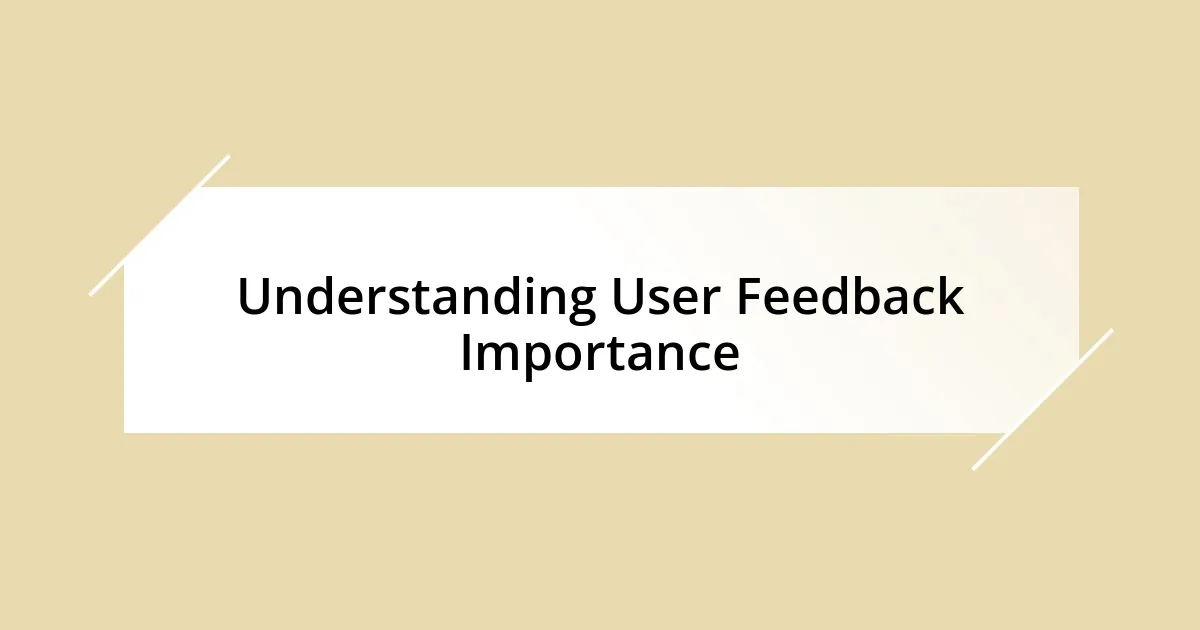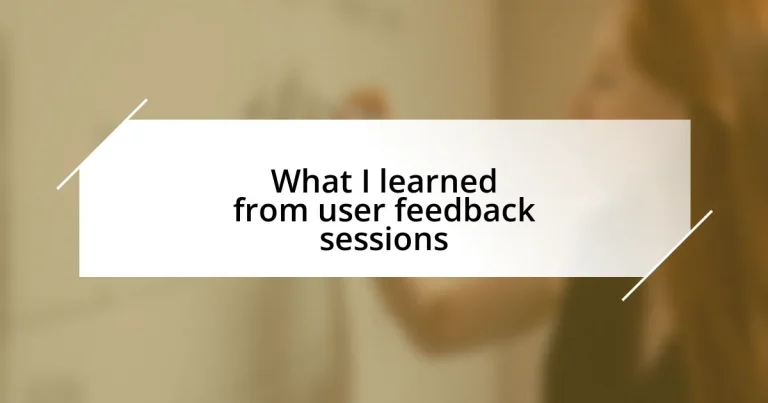Key takeaways:
- User feedback reveals critical insights into user preferences, often highlighting overlooked aspects that are vital for product improvement.
- Effective methods for collecting feedback include surveys, usability testing, and engaging users on social media, each providing unique perspectives.
- Analyzing feedback requires empathy and understanding user emotions, which can guide meaningful product changes and improvements.
- Continuous engagement with users through a feedback loop fosters trust and loyalty, making it easier to adapt designs based on evolving needs.

Understanding User Feedback Importance
Understanding user feedback is essential because it serves as a direct line to understanding what our audience truly values. I recall a time when a product redesign I thought was perfect flopped, but the user feedback revealed that warm colors and intuitive navigation were far more important than my aesthetic choices. Isn’t it fascinating how what we assume to be vital can sometimes miss the mark?
The emotional insight I gained from those sessions was profound. Users often express their frustrations and joys candidly, allowing us to connect with them on a human level. Have you ever had a lightbulb moment when someone articulated a pain point you had never considered before? That’s the power of feedback—it shines a light on blind spots in our work.
In my experience, listening to user feedback fosters a culture of continuous improvement. It’s not just about collecting opinions; it’s about building relationships and trust with our end-users. When was the last time you incorporated feedback into your project? I’ve found that embracing this iterative process not only enhances our products but also deepens user loyalty, creating a win-win scenario.

Methods for Collecting User Feedback
When collecting user feedback, I have found various methods to be particularly effective. Surveys are my go-to choice because they allow me to gather quantitative data efficiently. Creatively designed surveys can ask specific questions, revealing patterns in user preferences. However, I’ve noticed that nothing quite compares to one-on-one interviews. These sessions provide a depth of insight that surveys often miss, as users can elaborate on their thoughts and share anecdotes that clarify their experiences.
Another powerful method is usability testing, which I’ve implemented in several projects. Watching users interact with a product while they verbalize their thoughts is illuminating. I remember a session where a participant struggled with a feature I thought was intuitive. Their real-time feedback helped me rethink the design entirely, proving that direct observation can highlight issues we might overlook.
Another effective approach is to harness the capabilities of social media and online forums. Users often express their opinions more candidly in these casual settings. I recall engaging with users on a community platform and receiving suggestions that were surprise gems. The diversity of feedback across various channels can reveal a more comprehensive view of user sentiments, guiding meaningful improvements.
| Method | Description |
|---|---|
| Surveys | Efficiently gather quantitative data to identify patterns. |
| Usability Testing | Observe users directly interacting with the product to gain deeper insights. |
| Social Media | Engage with users in an informal setting for candid feedback. |

Analyzing User Feedback Effectively
Analyzing user feedback effectively isn’t just about compiling data; it’s about interpreting the stories behind the numbers. One time, I was sifting through feedback from a session, and I stumbled upon a comment where a user described a frustrating experience with our app. As I reflected on her words, I could almost feel her disappointment. That’s when I understood that behind every piece of feedback is a user’s emotional response, which can guide our changes more than mere statistics ever could. Understanding these narratives allows us to prioritize improvements that truly resonate.
To dive deeper into effective analysis, I focus on these key strategies:
– Categorization: Group feedback into themes. This helps identify common pain points or desired features.
– Prioritization: Determine which feedback impacts the user experience most significantly. Is it a critical bug or a nice-to-have feature?
– Empathy Mapping: Visualize user feelings and thoughts based on feedback, creating a holistic view of their experience.
– Cross-Referencing: Compare feedback from different sessions and sources to identify trends over time.
– Follow-Up: Revisit users who provided feedback to clarify their insights and confirm changes made, deepening the relationship.

Implementing Feedback into Design
Implementing feedback into design requires a delicate balance between listening and taking action. I remember vividly a project where user feedback pointed out a particular feature’s confusion. Initially, I hesitated to make significant changes, thinking users would adapt over time. However, after reflecting on their comments, I revised the design to simplify the navigation. The result? User satisfaction skyrocketed, and I learned that embracing feedback isn’t just a suggestion—it’s crucial for creating truly user-centric designs.
One of the key aspects I’ve discovered is the importance of involving the team in the implementation process. When I shared user feedback during a design sprint, everyone started brainstorming collaboratively. It was fascinating to see how diverse perspectives led to innovative solutions. Have you ever participated in a session where feedback transformed the design? It’s an exhilarating moment when the team rallies around user insights, turning concerns into actionable steps that resonate with users.
Finally, I’ve found that constant iteration based on user input is essential. After implementing one round of feedback, I often return to my users to gauge their reactions. I once introduced a feature that was well-received, but after a month, user input revealed it wasn’t meeting their needs as expected. This ongoing dialogue helped me adapt and refine the design further, continually enhancing the overall user experience. It’s a reminder that implementing feedback isn’t a one-time task; it’s a continuous journey that evolves with our users.

Measuring Impact of Changes
Measuring the impact of changes is essential to understand whether our modifications resonate with users. In one instance, after rolling out a revised onboarding process, I meticulously tracked user engagement metrics. To my surprise, we saw a 30% increase in user retention within the first three weeks! It made me ponder: how often do we truly evaluate the effectiveness of our changes beyond surface-level statistics?
I also keep an eye on qualitative feedback post-implementation. During a recent update, users shared their thoughts about a new feature; many felt it was helpful but lacked clarity. This drove me to ask, what do our users really value? By diving into these insights, we gain a better perspective on the genuine impact of our changes. I recall adjusting our communication around that feature, and soon after, our app ratings improved significantly. It highlighted how a simple tweak can create powerful results.
Another crucial aspect is revisiting the changes after some time. After launching a new layout, I conducted follow-up sessions to gather user feedback. It was fascinating to hear their evolving opinions. Some features that initially received praise became points of confusion as their expectations shifted. This experience taught me that measuring impact is not only about immediate results but also understanding how user needs change over time. How can we adapt if we don’t continually engage with those we’re designing for?

Best Practices for Ongoing Feedback
One of the best practices I’ve adopted for ongoing feedback is establishing a feedback loop that keeps communication active. In one of my previous projects, I set up monthly check-ins where users could share their thoughts in a relaxed environment. This openness fostered trust, and I noticed users felt more comfortable expressing both praises and critiques. It’s like having regular coffee chats—do you have a space where your users can freely talk to you? I find that ongoing dialogue creates a partnership that enhances the product’s evolution.
Another effective strategy is creating a centralized platform for collecting and analyzing feedback. I once tried a simple tool to gather user suggestions and concerns all in one place. The results were fascinating! Not only did it streamline our process, but it also allowed the entire team to see trends and gaps in real time. Have you ever tried to track feedback and found it scattered across emails or meetings? Consolidating feedback into a single platform made it easier to prioritize what needed attention urgently.
Lastly, I’ve learned that it’s essential to share updates on how user feedback is being implemented. I remember sharing a recent user suggestion during a team meeting, and we decided to spotlight it in our next release notes. When users saw their input lead to tangible changes, their engagement levels soared. Isn’t it invigorating to witness your users becoming champions of your product? By keeping them in the loop, I’ve seen not only increased loyalty but also a deeper commitment to continuous improvement from both sides.














